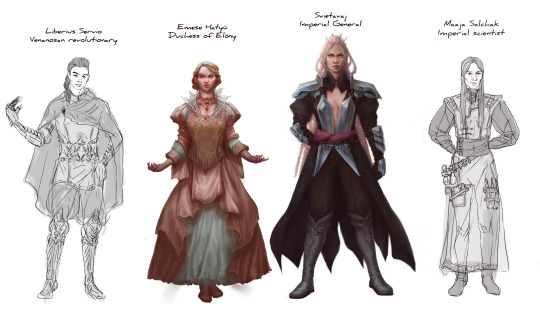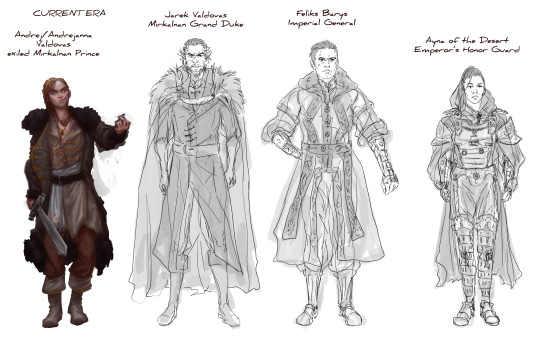#valecny
Text





Just as I finally got all this put together, I realized there's four more minor characters whose designs aren't on here because they were quickly sketched in a different style. RIP
#artists on tumblr#original character#original#valecny#empire of valecny#dominik#rusalje#zydrunas#andrej#khenvish#ayna#jarek#barys#liberius#emese#svietavaj#maaja#lisandre#alyok
4 notes
·
View notes
Text


Posting this on here because it's still a WIP and I stopped posting those on the art blog back when I had a lot of active followers so it looks weird now to me but I'm really happy to be repainting some of my older stuff because I have a way stronger idea of what Valecny should look like now that I'm no longer trying to get work in fantasy illustration and no longer need pieces that look like the house style of any major tabletop companies
1 note
·
View note
Link
0 notes
Photo

Slavný americký válečný hrdina byl ženou nebo intersexuálem
Polský šlechtic Casimir Pulaski zachránil během války za nezávislost život Georgi Washingtonovi a je považován za "otce americké kavalerie". Za jeho ... (více v odkazu níže) https://www.politiq.cz/2019/07/23/slavny-americky-valecny-hrdina-byl-zenou-nebo-intersexualem/
0 notes
Text
Region: The Grand Duchy of Mirkalnas
Geography: The landscape of Mirkalnas is composed entirely of the barren, rugged Bezgalig mountains. Agriculture is primarily limited to horticulture or the fertile regions found in the alluvial fans. The spring rains and the melting of snow from the peaks feed into rivers and aquifers.
The lower elevations to the north feature karst topography, and the region is noted for its caves.
Climate: semi-arid warm to hot summers and cold to very cold winters.
Population density: Outside of the larger cities, Mirkalnas is largely rural. Due to the geography, much of Mirkalnas is unable to support larger communities. Scattered towns and holdings dot the higher hills and line the roads and rivers.
While education is available in the cities, most of the rural population are illiterate.
Major metropolitan areas: capital city: Valmiris - situated in a narrow river valley - elevation 5kft
other cities: Bez Citu - elevation 8kft (ancient hill fort)
Landmarks: Visvarak - highest peak - 20,000 feet
Lirkytas - high elevation lake
Flora: Only the hardy species endure the sides of the rocky cliffs. Few of Mirkalnas' trees are deciduous. A variety of scrubby white-trunked pale-needled juniper is common. It produces bitter, hard yellow berries that are used in dyes and many local foods and drinks.
There are several species of starchy tubers that are native to the lower elevations of the region. A breed of thin-skinned, elongated yam beans named batatai are a staple in the diet as they can be easily stored outside their season.
Fauna: The livestock of Mirkalnas are mostly thick-furred hooved animals well adapted to the region's extremes. Goats in particular are common, both wild and domesticated - as domesticated as any goat or Mirkalnan creature could ever be, at least. Mountain lions are common, but rarely found near inhabited areas.
Resources: copper, precious metals
Imports: spices, dyes, czerocite
Exports: non-ferrous metals, wool, textiles, bandits
Political structure: House Valdovas has been the ruling house for six generations. Their sigil is an ibex. Brutal coups are not uncommon within the ruling house or noble houses. The current Grand Duke succeeded his own father only following a bloody campaign. His first ruling, to execute the heads of every house that supported his father's regime, oddly enough increased his popularity among his people.
Leaders: Grand Duke Jarek Valdovas
Religion: Mirkalnans practice ritual sky-burials, the end to a lengthy funereal process. A vigil begins at the death, and the body is interred in a closed room with incense. Only shamans and sorcerers are permitted to touch the flesh of the deceased during this time. The duration of this varies -for the poor or those without survivors this process may last as little as two hours, to as long as two days for the heads of noble houses. Time periods in between the maximum and minimum tend to end on odd-numbered hours or days out of superstition rather than tradition.
The bodies of enemies are burned. Fire is seen as a cleansing agent. While all corpses are feared for disease, it is believed that all enemy corpses are actively unclean and even sorcerers and shamans are not permitted to touch them.
Air is revered as the highest of elements.
Because any method of corpse disposal that does not allow for a period of decay does not allow the magic once contained in the body to fester and congeal into czernocite, Mirkalnas is extremely poor in the essential mineral. And as the swamps of Vökdoaht control research into czernocite, most speculation as to the reason Mirkalnas is so barren of the rock assumes the limited population density or animal/plant life is the chief culprit.
Mirkalnans are often considered superstitious and spiritual, but most other regions believe they have no formal religions. This is not true, though most are contained to smaller cults. Mirkalnan beliefs often go unrecognized by the other citizens of the Empire as they do not typically integrate ethical practices or moral guidelines. As a result, it is often said that Mirkalnans prize survival over ethics, though this isn’t entirely accurate. Culturally, it would be truer to say that survival of all or most is prized over arbitrary limits on the method to achieve it, an attitude that is likely the only reason any civilization has managed to withstand the harsh landscape of the Bezgaligs.
History: Mirkalnas evolved out of a chiefdom of warring, predominantly nomadic tribes. The dearth of necessary resources and the harsh climate engendered a heavily martial culture out of need. Despite the economic factors that necessitated their integration into the Empire, Mirkalnas retained a spirit of fierce independence. Throughout the history of the region as a province of Valecny, Mirkalnan leaders have celebrated local political victories by publicly aligning themselves against the leadership of the Empire, though few have gone so far as to make themselves actively enemies of the state.
Uprisings from Mirkalnas, no matter how token, have been swiftly put down from the capital through economic sanctions rather than outright war. Largely it has been an effective strategy; past Emperors have seen little to be gained in an outright offense against the region when the geography renders much of it impassable to a large host.
Recent generations of Grand Dukes have drawn further away from the Empire, invoking harsher reactions and greater retaliation. Given the dependence of Mirkalnas’ martial efforts on the iron of their neighbors, trade embargoes and minor redistricting have diminished the power and borders of Mirkalnas in recent years. Despite – and likely as a result of – these measures, Mirkalnas has only grown more aggressive and isolationist.
Architecture: Most buildings are stone, though houses are usually thatched with veja- a stiff, dry grass that is common. In more remote areas, shepherds and hunters commonly create entire seasonal huts out of it. The larger cities are often built imposingly, massive towers and tall fortresses that defy the expectations the rest of the Empire has of vicious mountain barbarians. The sharp inclines of the mountains lends itself to cities that consist heavily of mazes of stone staircases and paths winding up and through the landscape.
0 notes
Text
0 notes
Text
0 notes
Text
Válečný kůň - příběh slavného koně během první světové války
Předlohou k filmovému scénáři se stala kniha War Horse anglického spisovatele a dramatika Michaela Morpurga. Kniha oslovila mnoho čtenářů a Nick Stafford ji upravil do divadelní hry, která měla premiéru v roce 2007. Velice úspěšnou inscenaci viděl i režisér Steven Spielberg a rozhodl se pro filmovou adaptaci. Vsadil na osvědčený a diváky prověřený námět o přátelství , odvaze a vztazích obyčejných lidí v době válečného konfliktu. Ve filmu však, oproti původní předloze, zvýraznil příběh mladého Alberta a válečné příběhy postavil jako životní pouť, která začíná a končí doma na farmě.Farmář Ted Narracott( Peter Mullan) koupí na trhu hříbě ušlechtilého koně. Farmářův syn Albert( Jeremy Irvine) dá koni jméno Joey a začne se o něj starat. Joey si s Albertem dobře rozumí a společně dokážou, že zvládnou i tu nejtvrdší práci na farmě. Ted Narracott má však finanční problémy a začátkem války se rozhodne koně prodat vojenské kavalérii. Protože vztah mezi Albertem a Joey je velice silný, chce Albert narukovat a jít do války také. Je však příliš mladý, a tak jen slibuje, že svého koně najde. Začíná pouť válečného koně po bojištích první světové války. V první bitvě padne jeho první pán, kapitán Nicholls (Tom Hiddleston), následuje zajetí a služba v německé armádě. Při dobrodružství s mladými německými vojáky se Joey dostane na usedlost, kde se o něj stará děvčátko Emilka(Celine Buckens) a její dědeček(Niels Arestrup). Po krátký čas se válka ozývá jen vzdálenou střelbou. Následuje setkání s opravdu těžkou vojenskou technikou a Joey se , stejně jako ostatní koně, vyčerpává při táhnutí mohutných děl. Těžká a namáhavá práce, neustálý hluk a válečná mašinérie drtí lidi i zvířata. Při následující válečné bitvě, kde se objeví i tanky, Joey zaběhne až do prostoru plného ostnatých drátů s překážek. V „ území nikoho“ zůstává poraněný a zamotaný mezi dráty. Na jeho osvobození se podílí vojáci z protilehlých nepřátelských stran. Ke konci války se zraněný Albert setkává se svým koněm a v záři červánků dojdou až na svou farmu.- Více na https://www.kritiky.cz/filmove-recenze/retro-filmove-recenze/2019/valecny-kun-pribeh-slavneho-kone-behem-prvni-svetove-valky/
#Retro filmové recenze#Benedict Cumberbatch#David Thewlis#Eddie Marsan#Emily Watson#John Williams#Liam Cunningham#Nicolas Bro#Rainer Bock#Sebastian Hülk#Steven Spielberg#Toby Kebbell#Tom Hiddleston
0 notes
Photo

LIGHTLESS
#empire of valecny#svietavaj#valecny#original#do you guys know how hard it is to paint saying#sorry mommy sorry mommy to your own OC over and over again
92 notes
·
View notes
Video
youtube
Zítra vstanu a opařím se čajem (1977)
recenze CSFD
osobní hodnocení 77%
0 notes
Link
Dusot koní, svištění oštěpů vzduchem, hlasité výkřiky, zmítání těl v euforickém opojení a majestátní jezdci. Pasola. Válečný rituál, při kterém v minulosti tekla krev a umírali lidé. Dnes jsou ostré hroty oštěpů zakázány a podle místních jde spíše o hru podobnou sportovnímu utkání. Já jsem však měla úplně jiný dojem.
0 notes
Photo

31 notes
·
View notes
Photo

spirits of the sands
#this one is a few months old I forgot to post it#valecny#original#aydin#artists on tumblr#empire of valecny
22 notes
·
View notes
